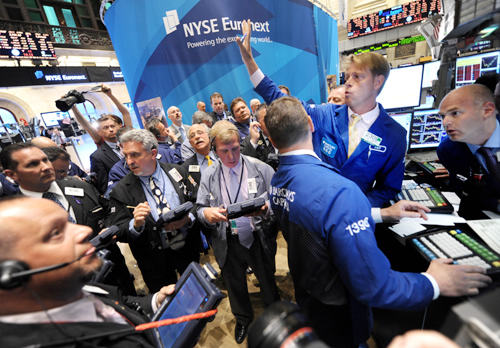|
 |
|
MARKET IMPACT: Traders at the New York Stock Exchange on June 1, the day major U.S. stock indexes fell sharply following Moody's lowering of Greece's sovereign credit rating (SHEN HONG) |
Following the global financial crisis in 2008, rating agencies Moody's, Standard & Poor's and Fitch Ratings came under the limelight. They were deeply implicated in the sub-prime mortgage crisis—high ratings of many risky sub-prime debts blinded investors, touching off the crisis. In recent years, they have lowered the ratings of debts in PIGS countries—Portugal, Ireland, Greece and Spain—and threatened to throw more European debts into the "junk" pile.
The alarms they sounded not only have hidden the real problems behind the global financial crisis, but also are hindering efforts to alleviate the euro-zone sovereign debt crisis. So it all begs the question: Are rating agencies more angelic or demonic in nature? Either way, their behavior need to be reconsidered.
Angels at first
Credit rating is nothing new. The three credit rating agencies in question all have century-old histories. Credit rating, in a modern sense, started in the United States in the early 20th century when companies with various financial backgrounds began to issue bonds to build railways to make money.
But because corporate information was opaque and companies' finances and credit were not completely open and available for analysis, defaults on debts were hard to avoid, creating a major headache for investors.
In 1909, John Moody, the founder of the Moody's rating agency, sensed a business opportunity in the making. He published a manual on U.S. railway investment. Since this was the first rating of bonds issued by various railway companies, Moody's venture was instantly successful.
In the early years of the 20th century, the U.S. economy boomed, so financial problems were few, leaving rating companies with little to disclose. This allowed them to fall to the wayside of public concern.
The Great Depression struck in the 1930s, causing numerous companies to go bankrupt leaving their debts unpaid. Then people found out those companies had been given low ratings by credit rating agencies—it should have been no surprise that the companies went under. Since then, credit rating has been regarded as an important standard by bond investors, allowing credit rating agencies to establish their reputations as guardians of investors.
Not that virtuous
Rating agencies make money by selling rating reports, particularly in times of economic turmoil. They face financial difficulties when the economy booms because rating information is irrelevant when investment opportunities are abundant and risks are low.
Growth counter to economic cycles is an important reason for considering these agencies to be more sinister than altruistic.
First, countercyclical growth of rating agencies helped change pricing methods. Before the 1970s, revenue streams for rating agencies mainly came from rating reports purchased by bond investors. When the economy entered an expansion phase, however, these investors would not buy their reports. But rating agencies also found that whether the economy was good or bad, bond issuers were always in favor of fair ratings. In the early 1970s, rating agencies changed their way of charging, releasing free reports to readers while charging bond issuers to make ratings.
The downside of this new pattern is a dilemma in deciding which user base to be loyal to: bond issuers who pay or readers who don't. The massive high-rating sub-prime mortgages during the sub-prime crisis prove that sometimes rating agencies are obviously loyal to those who pay.
Second, countercyclical growth of rating agencies promotes countercyclical growth of goodwill and trust. The long history of rating agencies must be attributed to the accuracy of ratings. In other words, if rating agencies make too many inaccurate ratings, their reputation will be tarnished.
| 